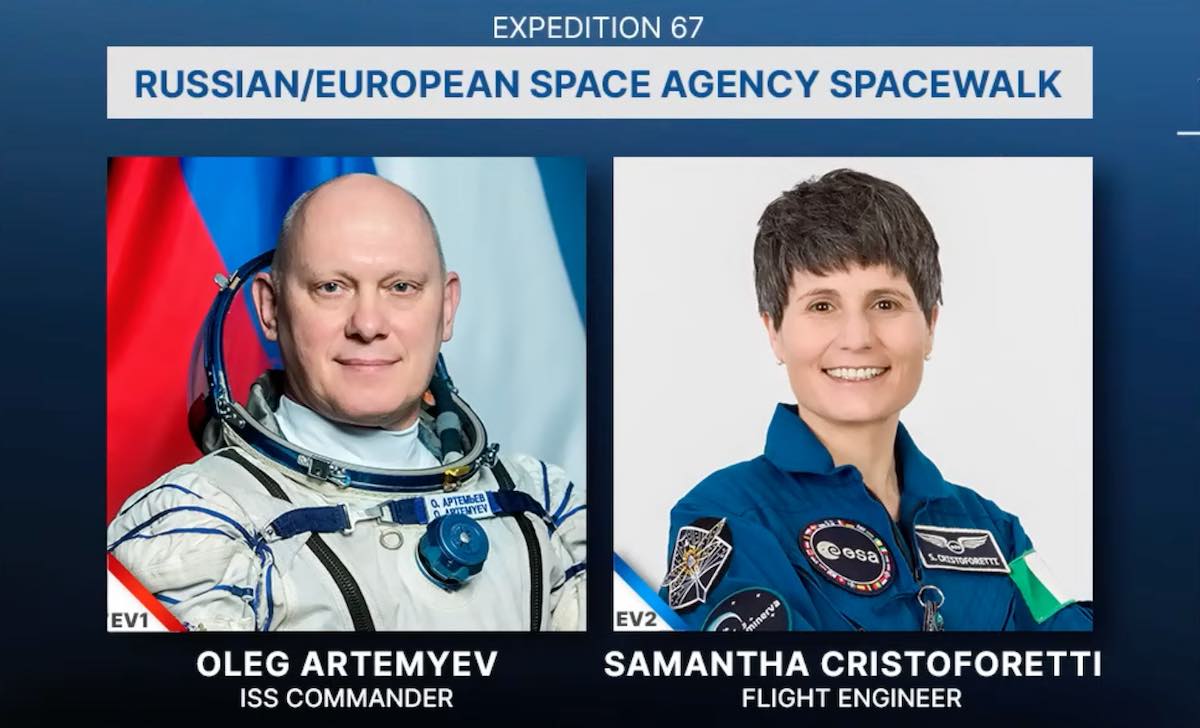
Russian cosmonaut Oleg Artemyev and European astronaut Samantha Cristoforetti headed outside the International Space Station on a rare joint spacewalk Thursday. They continued outfitting a European robotic arm and deployed 10 nanosatellites for radio technology experiments.
Artemyev and Cristoforetti opened the hatch to the space station’s Poisk airlock at 10:50 a.m. EDT (1450 GMT) Thursday, marking the official start of the spacewalk.
The spacewalkers installed an adapter for the European Robotic Arm on the outside of the Poisk airlock module, and set the arm’s external control panel into a hibernation mode until it is needed again on a future spacewalk. Thursday’s excursion was the third spacewalk to activate the European Robotic Arm and prepare it for future operations to relocate hardware outside the Russian segment of the space station.
The arm launched last July with Russia’s Nauka multipurpose lab module.
The joint spacewalk, or EVA, is a rarity. The last time a non-Russian astronaut performed a spacewalk in a Russian Orlan spacesuit was in 2009, when NASA astronauts worked with Russian crewmates outside the station. Cristoforetti, a former Italian Air Force pilot, became the fourth European astronaut to conduct a spacewalk in a Russian spacesuit, but the first European to do it outside the International Space Station.
The previous European astronauts that performed spacewalks in Russian spacesuits did it outside the Russian Mir space station in the 1980s and 1990s.
The spacewalk Thursday was the 251st spacewalk for assembly, maintenance, and upgrades of the International Space Station, and the sixth excursion outside the ISS this year.
Other tasks on Thursday’s spacewalk included the hand-deployment of 10 small Russian nanosatellites to perform radio technology experiments in low Earth orbit. Artemyev gently tossed the shoebox-sized nanosatellites into space one at a time, guiding them on retrograde trajectory behind the space station.
“Samanatha, we are a launch complex, but we are powered by our muscle strength,” Artemyev remarked to Cristoforetti during the CubeSat deployments.
The CubeSats were launched inside Russian Progress supply ships in February and June, then carried outside the station by Artemyev and Cristoforetti. The eight YuZGU and two Tsiolkovsky-Ryazan CubeSats deployed Thursday were developed at Southwestern State University in Kursk, Russia.
The small research satellites are expected to naturally re-enter the Earth’s atmosphere within a few months.
Russian cosmonaut Oleg Artemyev has begun tossing small nanosatellites into space outside the International Space Station. Ten nanosatellites will be deployed to perform radio technology experiments in orbit.
Watch the spacewalk live: https://t.co/IlGdN4lJhe pic.twitter.com/KwGdOWDnu8
— Spaceflight Now (@SpaceflightNow) July 21, 2022
The work on the European Robotic Arm helped prepare the crane-like structure to move an airlock stowed outside Russia’s Rassvet module to its future home on the Nauka module. That relocation will occur on a future Russian spacewalk.
Artmeyev and Cristoforetti also replaced a protective window on a camera lighting unit on the hand of the European Robotic Arm.
Another task on the spacewalk timeline was the extension of a telescoping Strela boom from the Zarya module toward the Poisk airlock to help facilitate movement of crew members and hardware on future spacewalks.
Despite protests from Artemyev, Russian mission controllers decided to forego that objective after the spacewalk ran behind schedule.
“I’m telling you we could have completed everything while everybody’s thinking,” Artemyev said through an interpreter.
“No, we’re done thinking. The decision has been made, we’re going back to the EV (airlock) hatch,” replied a spacecraft communicator in Russian mission control near Moscow.
Artemyev and Cristoforetti re-entered the Poisk airlock and closed the hatch at 5:55 p.m. EDT (2155 GMT) to wrap up the 7-hour, 5-minute spacewalk.

The Russian-led spacewalk occurred as the U.S. spacesuits on the International Space Station remain unavailable for all but emergency spacewalks. NASA is investigating the cause of a water leak noticed during a March spacewalk using a U.S. spacesuit.
The European Robotic Arm is the third system of its kind at the station, joining the Canadian and Japanese robot arms on the U.S. section of the research complex.
Like the Canadian robotic arm, the European arm has the ability to “inchworm” between grapple fixtures, or base points, at multiple locations on the space station. While the Canadian arm is positioned on the U.S. segment of the complex, the European arm has access to the Russian modules.
Full-scale development of the European Robotic Arm began in 1996, and the arm was in storage more than a decade to wait for Russia’s Nauka lab module to be ready for launch. The European arm, primarily built in the Netherlands, was originally planned for launch on a NASA space shuttle.
“ERA is a bit different than the other manipulators that already on the station,” said Philippe Schoonejansm, the European Space Agency’s ERA project manager. “It can be fully preprogrammed in advance, which is helpful. It can be operated from external control panel, which the others do not have. So even when you’re doing a spacewalk, you can control ERA by just seeing and operating this control panel. But also it can operated from inside using only a laptop, so it doesn’t need any joysticks.”
ESA says the arm capable of carrying a load of more than 17,000 pounds, or 8 metric tons, with a precision of one-fifth of an inch (5 millimeters). The arm extends about 37 feet (11.3 meters) in length.
Email the author.
Follow Stephen Clark on Twitter: @StephenClark1.
